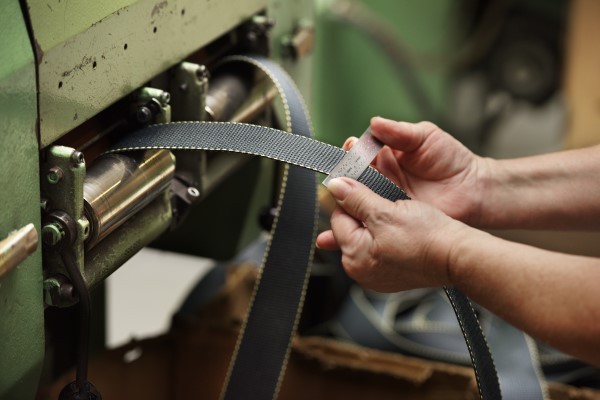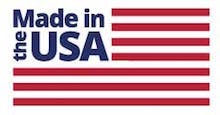When most people hear the term “webbing” they likely first think of spiders, or perhaps the skin between a duck’s toes. What they may not realize is that this category of textile surrounds us in our everyday lives and is among the most broadly applied and useful of all fabric components. Webbings are so prevalent in fact, that we barely take notice of them, but without which, their absence would be sorely missed.
Webbing is commonly described as “a strong fabric, woven as a flat strip or tube of varying width and fibers,” and whether as dog leashes, or straps on a backpack, or a belt to hold up our pants, most webbings are typically produced from common man-made, or natural materials, such as nylon, polyester, or cotton. As with all textiles, these fibers are chosen based upon the needs of the final application of the webbing, the availability, and, of course, the cost.
Webbings are differentiated from other narrow fabrics, such as tapes and/or trims, primarily through their greater tensile strength (a measure of maximum force attained in breaking a fiber, or fabric) and for this reason, webbings tend to be thicker and heavier. Elastics – another main category of narrow fabrics – differ from the others in their ability to stretch.
Safety Webbing: Product Applications
While all webbings are required, by their very definition, to meet certain performance criteria, Specialty webbings are those that are engineered to push specific performance goals to levels too extreme for standard, “commodity” webbings. These include webbings for applications in Flood Protection/Critical Infrastructure, Military/Defense, Fire Safety, Load Bearing/Lift Rigging, Industrial Safety/Fall Protection, and many others that have very rigorous standards. Many, or most of these fall under the heading of what is considered Safety Webbing and are included in such final applications as:
- Fall protection harnesses, lifelines, and lanyards
- Fire safety SCBAs (single contained breathing apparatus) and drag rescue lines
- High-performance crane slings
- Military safety harnesses
- Arc-flash resistant harnesses, lifelines, and lanyards
- Construction safety netting
- Flood barriers and curtains
- Many others
Performance Aims of Safety Webbing
When considering and defining the performance goals of such mission critical components, it is vital that all aspects of the final product’s application, environment, lifespan, and maintenance be carefully reviewed. At OTEX Specialty Narrow Fabrics, our Research and Development team utilize an exclusive, in-depth survey to provide a complete narrative of all performance needs/challenges a customer may anticipate, as well as those they do not. This, to the ultimate end of engineering the best possible textile for their specific need(s). Common requirements for Safety Webbings may include (but not necessarily be limited to):
- Cut resistance
- Abrasion resistance
- Fire/flame resistance
- Heat Resistance
- Arc-flash resistance
- Chemical Resistance
- Hydrophobicity (water/moisture resistance, including salt water)
- UV light resistance
- Extreme tensile strength
- Resistance to creep (the slow deformation of a material under constant stress)
Choosing the Right Materials for Optimal Performance
In addition to the weave design and size specifications, very particular fiber materials are chosen for their specific performance abilities. These may be utilized independently, or in combination with other specialty fibers, in order to meet difficult-to-achieve performance targets. Those often selected for the above-mentioned webbing applications and goals include:
- Kevlar (fire, flame, heat, arc-flash, abrasion, and cut resistance, tensile strength)
- Spectra / Dyneema / UHMWPE (hydrophobicity, UV & chemical resistance, extreme cut / abrasion resistance)
- Technora (fire, flame, heat, arc-flash, abrasion, and cut resistance, tensile strength)
- Twaron (fire, flame, heat, arc-flash, abrasion, and cut resistance, tensile strength)
- Vectran (fire, flame, heat, arc-flash, abrasion, and cut resistance, tensile strength)
- PBI (fire, flame, heat, arc-flash, abrasion, and cut resistance, tensile strength)
- Nomex (fire, flame, heat, arc-flash, chemical resistance, softness)
- Zylon (fire, flame, heat, arc-flash, abrasion, and cut resistance, tensile strength)
Safety Webbing: Standards and Certifications
Since lives and property depend on the quality and consistency of such safety webbings, quality testing on the performance of both the materials and the webbings is constant and closely regulated. Testing methods and standards are established by various industry and independent certifying bodies/agencies. Some of those well-recognized by the specialty fabrics and related industries are:
- Underwriters Laboratories (UL)
- American Society for Testing and Materials (ASTM)
- International Organization for Standards (ISO)
- American National Standards Institute (ANSI)
- National Fire Prevention Association (NFPA)
- Web Sling and Tie Down Association (WSTDA)
Webbings are the workhorses of the narrow fabrics industry and specialty Safety Webbings are unquestionably the gold standard of that category. No other manufacturer is more experienced, or more renowned for designing and manufacturing specialty webbings, (as well as tapes, trims, tubing, and elastics) from high-performance fibers than OTEX Specialty Narrow Fabrics. Our team of designers, engineers, and technicians never stop exploring new materials and techniques to push performance ever further to ensure safety. If you and/or your associates are looking to source a narrow textile product with demanding physical properties, we invite you to contact us to discuss the unique challenges of your project/program. Our Sales, R&D, and Quality Assurance staff are happy to help you find exactly the right design for your needs. If it is not an existing product from our extensive catalogue, rest assured, nothing makes us more excited than engineering new custom textile solutions.



